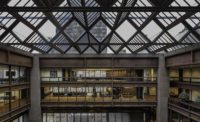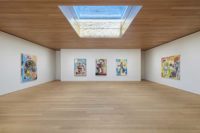A little over three years ago when the Ford Foundation’s president, Darren Walker, announced that the headquarters, based in New York, had hired Gensler to bring the 1967 structure into the 21st century, the news prompted a sense of dread. Nothing against the architectural firm, but what might be lost? Designed by Kevin Roche John Dinkeloo and Associates (and first published in RECORD in 1968), the granite-clad steel-and-glass 12-story building, wrapped around a 174-foot-high, skylit atrium, was revered as a gracefully elegant exemplar of architecture’s late Modern era.
Additional Content:
Jump to credits & specifications
While the foundation needed to meet current codes for fireproofing, asbestos abatement, and accessibility by 2019, Walker had a bigger reason for a redesign, one that would go to the heart of a shift in the Foundation’s mission. Ford originally bestowed grants to strengthen democratic institutions and reduce poverty worldwide—as well as foster the arts—but Walker believes it needs to be more collaborative, working closely with partner organizations on issues of social justice. That meant a building plan with more transparency and less hierarchy—and jettisoning most private offices. “We will be tearing down the walls separating us,” he claimed in a video interview with RECORD in February 2016.
By switching to an open office scheme, the Foundation could gain two floors to rent out to like-minded not-for-profits. The reconfiguration of the building’s total 415,000 square feet of space would also mean an increase of area for meetings and for the public. The philanthropy’s new name expresses these aspirations: the Ford Foundation Center for Social Justice.
Walker planned other changes as well: his presidential office suite on the 10th floor was so big it could be converted into three conference rooms, while he moved to a smaller office one floor below. The executive dining room would go; only a communal cafeteria on the 11th floor would remain. Finally, a space next to the main entrance would be transformed into a glassed-in lounge and café for those using the building.
But how could these architectural changes—particularly with workstations replacing the Midcentury Modern offices, with their custom leather, linen, brass, and mahogany furnishings and finishes—occur without sacrificing the original aura of glamour? Only the building’s exterior and the indoor atrium were protected by landmark status. Kevin Roche, who was not involved in the renovation, sounded wistful in RECORD’s video: “There are virtually no buildings or very few ... that have survived renovation. What building can you think of that hasn’t been fiddled with over the years?”
He need not have worried so much. Gensler managed the entire process of restoration and renovation, with the open plan that was critical to the project’s success. The original private offices had surrounded the glazed atrium, directly overlooking the garden. But they and the offices edging the perimeter of the building were enclosed by gypsum board walls and divided by a central corridor; there were few sweeping vistas from one side of the atrium through to the other.
In tearing down those walls and opening up each of the floors, Gensler created circulation paths along both the building’s exterior glazed walls and along the atrium, placing low workstations in between. “There was no vocabulary for workstations in the original design. We had to make it up—so we took cues from the legacy furniture and the architecture,” says Robin Klehr Avia, project principal of Gensler. Fabricated by Knoll, the 42-inch-high custom cubicles are impressive: made of an FSC-certified mahogany and leather panels with brass touches, their design took cues from existing furniture and even elevator-cab details. The architects also worked with Fisher Marantz Stone on the design of handsome custom linear brass light fixtures that are suspended over the desks.
Many original furnishings do survive. Gensler restored 1,500 pieces—more than half of those designed by Warren Platner—and otherwise replicated or reinterpreted the originals, keeping the dark brown, rust, gray, beige, and cream palette found throughout. The bold splashes of color that now punctuate common spaces come from the Foundation’s new collection of contemporary art, which focuses on work by women artists and artists of color, such as Kehinde Wiley, Carrie Mae Weems, and Dinh Q. Le. Even Nelson Mandela’s own drawings are on display.
To meet fire safety laws, Gensler installed a fire curtain, concealed in the ceiling, above the open steel railing of the 11th floor. An exhaust system on the same floor can draw smoke out of the atrium, and sprinklers—which never existed before—have been subtly inserted around the atrium walls.
For the public, the most significant aspects of the renovation will be the revamped atrium garden and a new double-height gallery on the first floor, which will present exhibitions on the theme of social justice. The garden, originally designed by Dan Kiley, used plants geared for a temperate climate, but they did not thrive in the enclosed space. Now reconceived by Raymond Jungles and his Miami-based Jungles Studio, the plantings are subtropical but chosen to resemble the original garden: ficus Amstel King trees with twisted trunks stand where magnolia trees once were located, while elsewhere a variety of plants such as Powderpuff and Shady Lady black olive trees and Creeping Charlie fill out the verdant setting. “We were trying to interpret what Kiley wanted—a quiet forest,” says Jungles, who also wanted to retain Kiley’s “processional movement through the space, with concealed and exposed views.” [Read an interview with Jungles in the February issue.]
Addressing ADA codes was central to that processional circulation. The atrium garden drops 13 feet in grade from the main entrance on 43rd Street down to the secondary one at 42nd. Only a broad brick stair brought people down one level before. Now a small glass elevator, discreetly tucked into the southeastern corner of the garden, will make this public space accessible. And standing inside the glazed atrium, the visitor will get glimpses of the surrounding urban context including Tudor City’s Gothic-style apartment towers.
Walker considers himself a tough client. Either that quality or his ebullient optimism—or both—has paid off: the building retains its serene identity and seems more translucent and transparent, and less forbidding, than it used to be. To be sure, the success of the renovation may not be apparent for some time, as the Foundation staff adapt to the open plan and enhanced conference space. But for those concerned that dragging this landmark into the 21st century would ruin it, they should acknowledge that the building has kept its elegance and stateliness. The sensitive renovation has left the ineffable aura intact.
Architectural Record Tours the Renovated Ford Foundation for Social Justice with President Darren Walker
The Ford Foundation Center for Social Justice's "Then and Now" Video
Architectural Record's 2016 Ford Foundation Tour with Architect Kevin Roche and Foundation President Darren Walker
CreditsArchitect: Gensler 1700 Broadway, Suite 400 New York, NY 10019 (212) 492-1400
Personnel in architect's firm who should receive special credit: Robin Klehr Avia, FIIDA, Project Principal Madeline Burke-Vigeland, AIA, Principal and Project Director Ed Wood, IIDA, Principal and Design Director Lydia Gould, CID, IIDA, Principal and Design Director Ambrose Aliaga-Kelly, AIA, Principal and Technical Director Johnathan Sandler, Principal and Strategy Director Bevin Savage-Yamazaki, Assoc. AIA, Project Manager Jonas Gabbai, LEED, Design Director Karen Pedrazzi, AIA, LEED, Technical Architect Thomas Turner, AIA, Architect Meghan Magee, CDT, LEED AP BD+C, LEED-AP, Designer Obi Elechi, Designer Anthony Harris, AIA, LEED, Architect Ian Korn, AIA, LEED, Architect Kate Sherwood, AIA, Design Manager David Briefel, LEED, Sustainability Director Lissa Krueger, Designer Brand and Graphics: John Bricker, AIGA, SEGD, Principal Craig Byers, Design Director, Brand Andrea Plenter Malzone Velez, SEGD, Graphic Designer Kevin Carlin, Project Manager, Brand
Interior designer: Gensler
Engineers: Mechanical, Electrical, Plumbing & Fire Protection Engineer: Jaros Baum & Bolles Exterior Envelope/Structural Engineer: Thornton Tomasetti
Consultants: Owners Representative: Levien & Company Landscape Design: Jungles Studio in collaboration with SiteWorks Landmarks Consultant: Higgins Quasebarth & Partners LLC Mechanical, Electrical, Plumbing & Fire Protection Engineer: Jaros Baum & Bolles Exterior Envelope/Structural Engineer: Thornton Tomasetti Lighting Designer: Fisher Marantz Stone Audio Visual, IT, Security & Acoustical: Cerami & Associates Food Service: Cini-Little International, Inc. Vertical Transportation: Van Deusen & Associates Fire Safety & Code Consultant: Milrose Consultants, Inc. Brick Conservator: Integrated Conservation Resources, Inc. Fitness Consultant: Club Design Concepts Atrium Fountain Consultant: Delta Fountains Fire/Smoke Modeling: Code Consultants, Professional Engineers, PC Risk Assessment: Thornton Tomasetti / Weidlinger Accessibility Consultant: United Spinal Brand and Graphics: Gensler
Specialty Contractors Furniture Restoration: Thomas J. Amato Co. Architectural Woodwork: Miller Blaker Lighting Restoration and Fabrication: Crenshaw Ornamental Metal Fabrication and Restoration: Amuneal Manufacturing Corp. Wood Flooring: Haywood Berk Floor Company, Inc. Architectural Concrete Flooring: Azzarone Contracting Flooring Installation: Architectural Flooring Resources Drapery and Window Treatment: DFB Sales
General contractor: Construction Manager: Henegan Construction Company
Photographer: © Ford Foundation / Richard Barnes |
SpecificationsExterior Cladding Metal panels: Centria Other cladding unique to this project: Core-Ten: Amuneal Dakota Granite: Pullman
Roofing Built-up roofing: Siplast Other: Pavers: Hanover Architectural Products
Glazing Glass: Bendheim
Doors Entrances: Ellison Bronze, Inc. Metal doors: Pioneer Wood doors: MillerBlaker, Inc. Sliding doors: International Office Concepts Special doors: Interior Doors: Dawson Doors Glass Doors: Beletz Bros. Glass Company Inc. Upswinging doors, other: Custom Doors: Ellison Bronze, Inc.
Hardware Closers: Rixson, LCN, Glynn-Johnson, Tormax Exit devices: Von Duprin Pulls: Legacy Security devices: HID Other special hardware: Smoke Curtain: McKeon
Interior Finishes Acoustical ceilings: Saint-Gobain Ecophon Armstrong Suspension grid: Saint-Gobain Ecophon Demountable partitions: International Office Concepts Interior Partition Systems Cabinetwork and custom woodwork: MillerBlaker, Inc. Paints and stains: Benjamin Moore Pratt & Lambert Wall coverings: Xorel Forbo Acrovyn Plastic laminate: Formica Wilsonart Solid surfacing: Dupont Zodiac Dupont Corian Special surfacing: Corian Wall Panel Floor and wall tile: Fireclay Tile Mosa Nemo Tile Resilient flooring: Marmoleum: Forbo Carpet: Bloomsburg Carpet Industries, Inc. J+J Flooring Group Raised flooring: Tate Flooring
Furnishings Furniture Manager: EvensonBest Office furniture: Knoll, Inc. Reception furniture: Legacy Furniture: Warren Platner Chairs: Legacy Furniture: Warren Platner Tables: Legacy Furniture: Warren Platner Upholstery: Holly Hunt Other furniture: Legacy Furniture: Warren Platner Halcon Walter Knoll Andreu World Vitra
Lighting Legacy Lighting Restoration and Fabrication: Crenshaw Dimming system or other lighting controls: Designplan Lighting Inc., Edison Price Lighting, ewo, Focal Point, H. E. Williams, Inc., JESCO Lighting Group, Lithonia Lighting, Lumenpulse, Reggiani, Tech Lighting, Zumtobel
Conveyance Elevators/escalators: Consultant: Van Deusen & Associates Construction: Nouveau Elevator Accessibility provisions: United Spinal Association
Plumbing Various Products: Lacava Various Products: TOTO
Energy Energy management or building automation system: BMS: Skyline Automation, Alerton Other unique products that contribute to sustainability: FSC certified white oak wood floors Add any additional building components or special equipment that made a significant contribution to this project: Targeting LEED platinum including overall 25% furniture reuse (includes 50% reuse of legacy furniture) |
















Post a comment to this article
Report Abusive Comment